October 26, 2014 / wanderinglightning / 0 Comments
I woke before dawn, before my alarm, in the upstairs dorm at Upaya Zen Center. I could just make out the outline of trees through the window. A dog barked indistinctly, some distance away, but otherwise, all was still. This quiet Sunday, my final morning of the weekend retreat, was in fact noticeably still. I felt fortunate to have awakened before the bellringer arrived, a resident in a brown robe who entered each adobe house at 5:30am to let the bell call us to practice… practice… practice….
I slipped out of bed, curling softly down the spiral metal staircase and out the door to the adjacent house, where our morning tea was available. No one in the kitchen; odd, since yesterday, several people came and went at nearly this same time. My mug of tea warm in my hands, I stood a moment in the courtyard between houses, looking up. Slowly twinkling stars answered back the silence we come here to find.
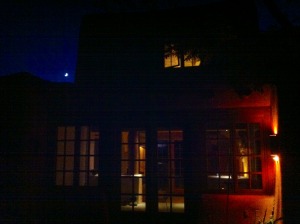
Quietly I returned, to my dorm, to the soft rug before the unused fireplace, to myself, here in this moment between all things, this silence alone. I sat on the rug and faced the windowed doors that lead out to the gardens, now black but faintly shining with the low lamplight. I sat, and I sipped tea, and I waited for the bellringer, and the morning.
It was when I’d nearly finished my tea that I wondered where the bellringer had gotten to. What time was it? I tiptoed back upstairs and checked my clock: 5:46. No one else was up. I walked out to the paths that lead to the zendo; I met no one. I passed the dark zendo and walked to the main hall; nothing stirred.
This is what I love and scratch my head about with Buddhists: just when you think you understand the rules of the game, they switch it up, to keep you from getting too comfortable with your ideas about yourself. Obviously, I had missed a very clear direction regarding today’s final schedule, but now when I looked for it posted, it was nowhere to be found. No signposts for me to get back on track. It was just up to me now, this morning, to choose how to respond: wait? go back to bed? practice on my own on the dorm room rug? yell out, “Olly olly oxen free”?
I lose track of time. Often. Or I grab it like a drum major thrusting that long, golden mace up high above the marching band, keeping such close count of the time it’s all I can see, all I can feel, all that matters. Until I drop it and lose all track again. Time, which I have long considered my nemesis, a trickster, coyote, was laughing at me again, silently under the stars.
La carretera is Spanish for both the road we travel and also the load we carry upon that road. I think of this as the burden we have loaded upon ourselves, usually. Time is often la carretera, the burden and the road, a long route which appears on the map as school, work, projects, deadlines, career, decisions – disillusionment, longing, and loss, followed inevitably by old age, sickness, and death, those tres amigos who live down at the end of that road.
“Well we know where we’re goin’
But we don’t know where we’ve been
And we know what we’re knowin’
But we can’t say what we’ve seen…” — Talking Heads, Road to Nowhere
I realized that today, however, with no one up, no one near, no schedule and no responsibilities left to complete here, I could do what I love to do when I find a beckoning doorway between the hours – run away. Off road. No map – spiritually speaking.
So I grabbed my pack and left Upaya before dawn, as if the rising sun would close that magic door. But it didn’t. It illuminated the Guadalupe of the City of Holy Faith, out front of the Santuario de Guadalupe Santa Fe, La Virgén standing serenely over the stooped men drifting slowly, one by one, across her sloping plaza by the river, under a glorious pink and orange sky.
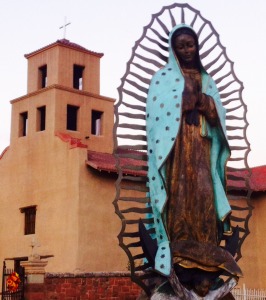 If you meet the buddha on the road, you’re supposed to kill him, according to the ancient Zen texts. They mean let go of what you believe enlightenment to be, your idealized personification of how to be in the world, usually defined as somehow not you. But what if you meet Guadalupe, over and over? I feel I am expanding, not limiting myself, by loving her personification of compassion, here among these quiet men with all the hallmarks of homelessness upon them. She feels reassuring to me, and her crowd feels very familiar.
If you meet the buddha on the road, you’re supposed to kill him, according to the ancient Zen texts. They mean let go of what you believe enlightenment to be, your idealized personification of how to be in the world, usually defined as somehow not you. But what if you meet Guadalupe, over and over? I feel I am expanding, not limiting myself, by loving her personification of compassion, here among these quiet men with all the hallmarks of homelessness upon them. She feels reassuring to me, and her crowd feels very familiar.
I just can’t kill her.
These musings occupied my mind as I left town, heading toward Taos – or so I thought, until I realized I was somehow going south. Even if you’re pretty good with maps, many of the roads between Santa Fe, Chimayo, and Taos stop and start, or simply do not appear on the map at all. Pulling over countless times to make U-turns, you have plenty of opportunity to review your relationship to maps and roads. I kept finding myself in the vicinity of where I wanted to be, without being able to figure out a road to actually get me there. So close and yet so far. And as I sat parked on the side of yet another winding road arcing away to who knows where, I thought about what I was doing.
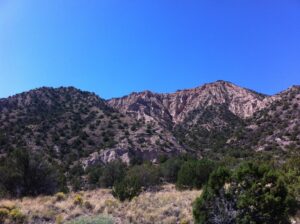
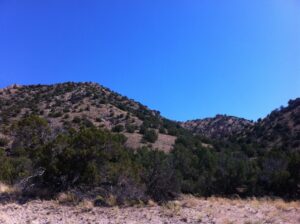
“…We’re not little children
And we know what we want
And the future is certain
Give us time to work it out…”
We choose our destination, and then we fit our roads to our course. But that’s not how it works in New Mexico. Or in life. I was trying to pick a direct route where none existed, trying to control my “off map” adventure by making it conform to the way maps work. The destination is a nice idea, but we can’t change the road or force it to get us there. Choose a different way…or a different destination. Or maybe, just quit choosing and controlling for a while. That is going off the map.
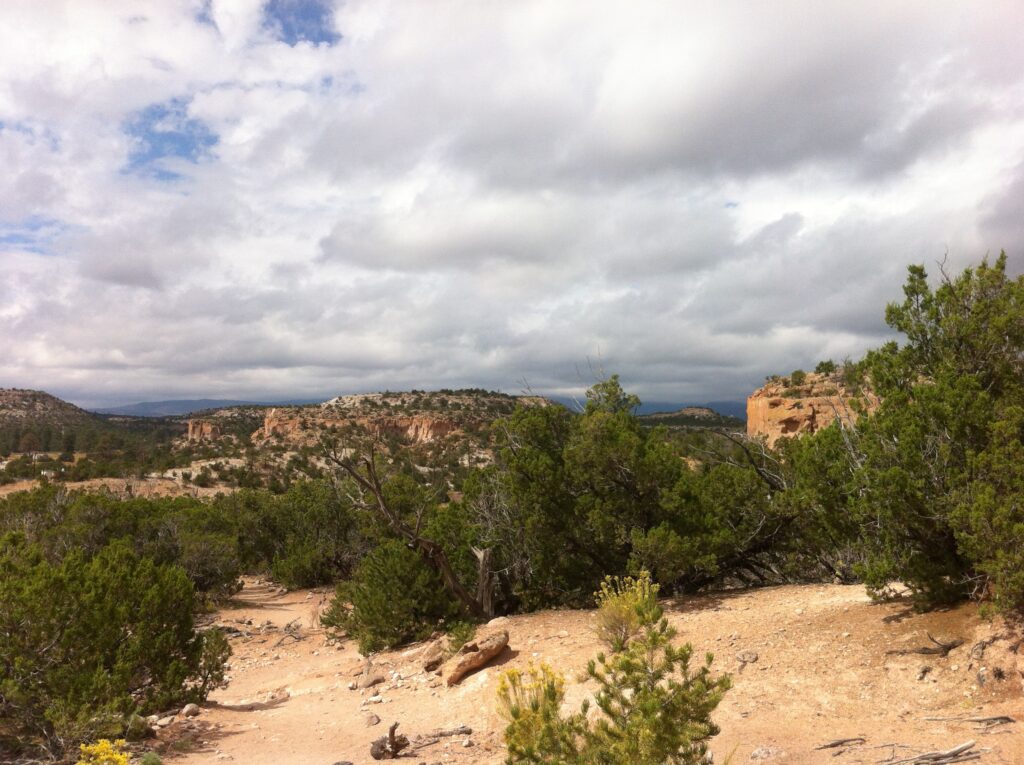
“We’re on a road to nowhere
Come on inside
Takin’ that ride to nowhere
We’ll take that ride…”
So I continued on whatever road I was on, and let myself relax into the easy swaying rhythm of curving among the hills, which brought me to the beautiful and mysterious places of northern New Mexico, to Bandelier, and Tsankawi.
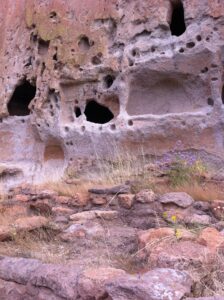
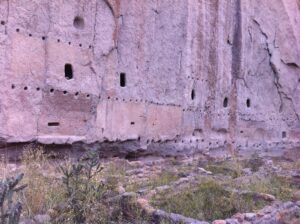
“I’m feelin’ okay this mornin’
And you know,
We’re on the road to paradise
Here we go, here we go…”
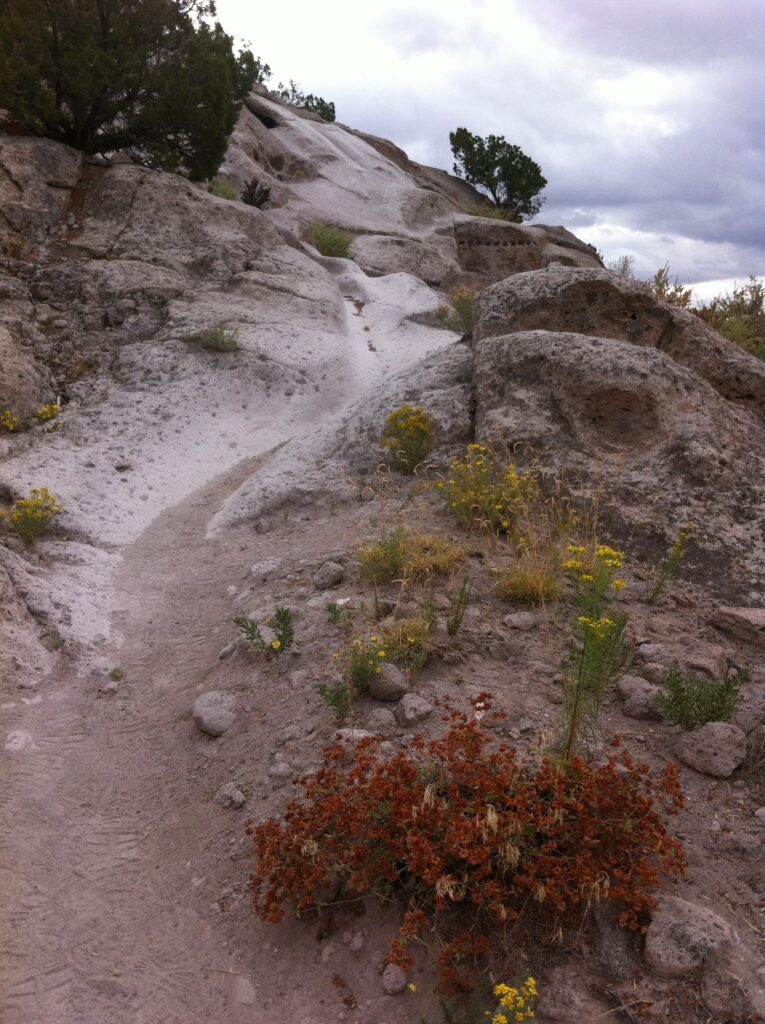
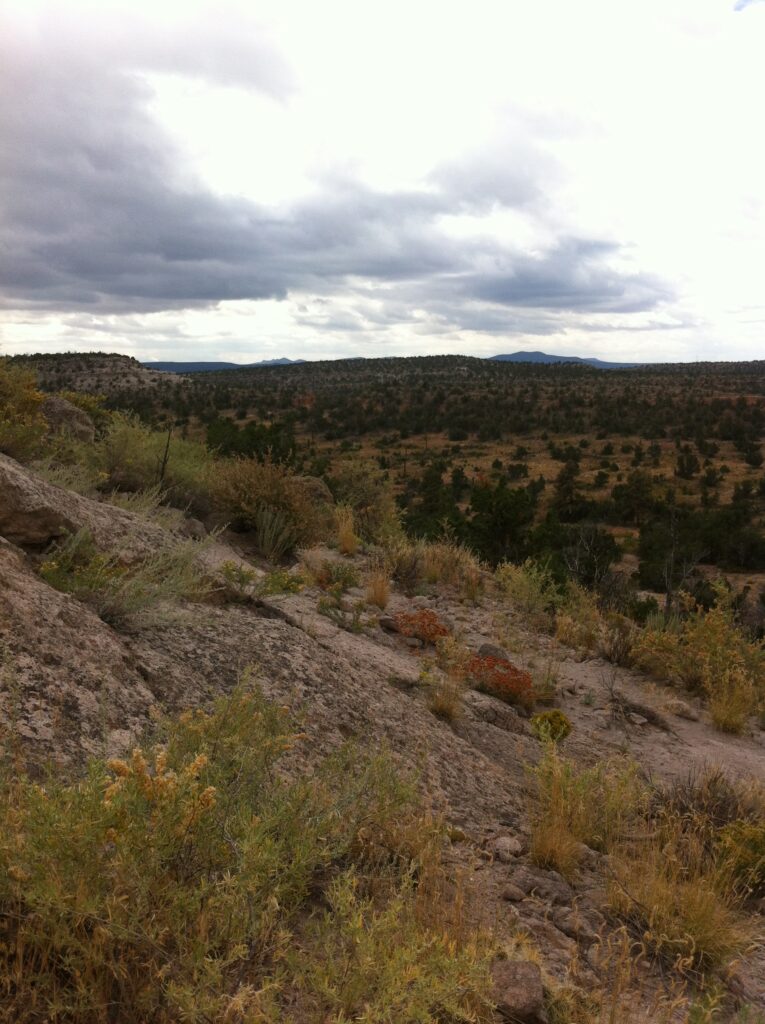
It’s fascinating that as maps and destinations lose their hold on you, time slips off your shoulders as well, and the day rolls out before you like a broad and inviting trail. I hiked and drove, and stopped and looked, and by more back roads Taos Mountain eventually came into view, and suddenly, by surprise, I arrived. I asked directions of a local woman manning a parking lot fee kiosk, ristras of chiles hanging all around her like fiery braids. She told me to “go five lights” to find my way back toward Tres Piedras and Colorado – five lights because that’s how they give directions here, since the roads keep changing directions. Follow the lights. Navigating by stars again.
The Rio Grande Gorge awaits you northwest of Taos, a farewell sendoff on the road home. As I crossed the bridge, I noted all the vendors displaying their wares along both sides of the road, on both ends of the bridge. After crossing I parked, to walk back and stand in the middle of the bridge over this spectacular, narrow canyon, the wind swaying the steel under my hands, the concrete under my feet.
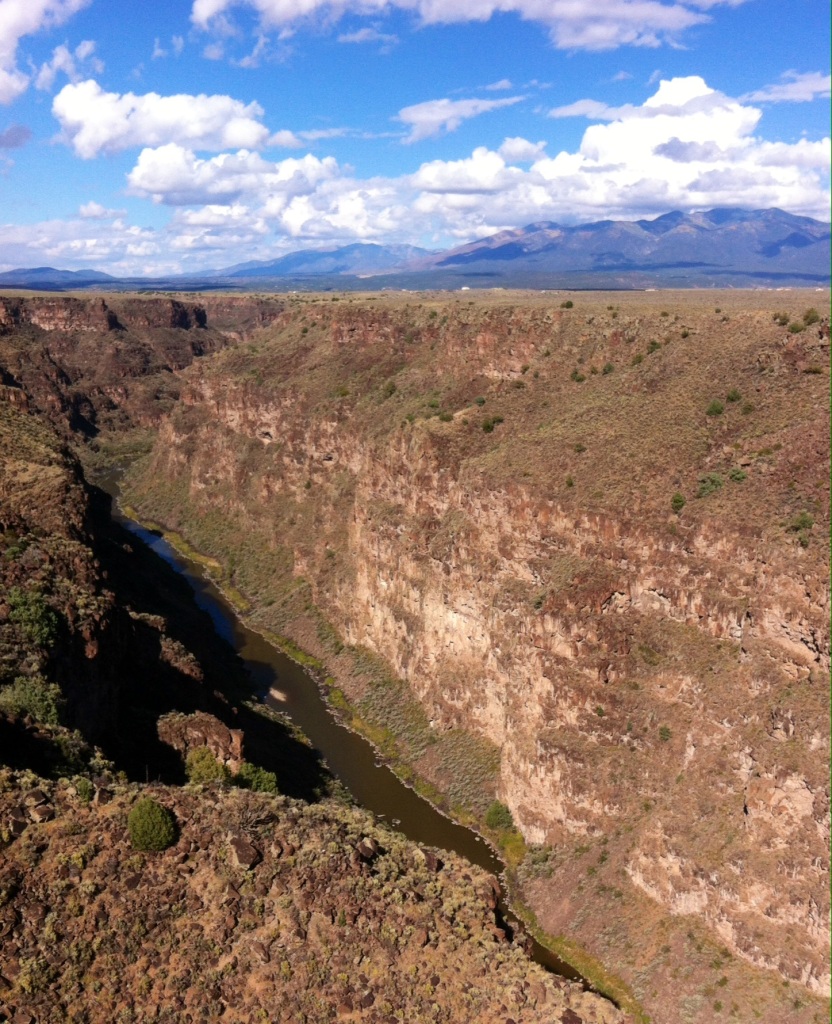 I turned to go, when one artist’s work caught my eye, and so I crossed back on foot to the Taos side of the bridge. Here sat Mark A on a folding chair outside his van, a big man with a woodworker’s hands and many hard years etched around kind eyes, carving an old gray wooden post into an icon of a saint, his other santos on the long white table in front of him. He sells them too cheap, he knows, but…, he says, and shrugs, smiling. An 8″ tall Mary and Joseph carved from tree branches stand together, their expressions loving and real; they must be sold together, I am told. Saint Francis sits solidly on the table holding a bird, clearly carved from the same type of gray post that will now become another image of Mother Mary. I pick up a smaller female image, with a crown and a long robe. “I just came from the zen center in Santa Fe,” I tell Mark A, “and this one reminds me of Kuan Yin. You know her?”
I turned to go, when one artist’s work caught my eye, and so I crossed back on foot to the Taos side of the bridge. Here sat Mark A on a folding chair outside his van, a big man with a woodworker’s hands and many hard years etched around kind eyes, carving an old gray wooden post into an icon of a saint, his other santos on the long white table in front of him. He sells them too cheap, he knows, but…, he says, and shrugs, smiling. An 8″ tall Mary and Joseph carved from tree branches stand together, their expressions loving and real; they must be sold together, I am told. Saint Francis sits solidly on the table holding a bird, clearly carved from the same type of gray post that will now become another image of Mother Mary. I pick up a smaller female image, with a crown and a long robe. “I just came from the zen center in Santa Fe,” I tell Mark A, “and this one reminds me of Kuan Yin. You know her?”
“Yeah, Kuan Yin, she is kind. My friend, he is one of the heads of the zen center we have here in Taos. He’s 94 years old, but he comes over to my house to visit me every day. I like zen. She was Mary, but she reminds you of Kuan Yin, yeah?” I want to tell him how much his work means to me, and how humbled I feel to have found him here on another road to nowhere. I buy the Kuan Yin, and Saint Francis, whose face reminds me of this santero, carver of saints. No killing this buddha on the road, either.
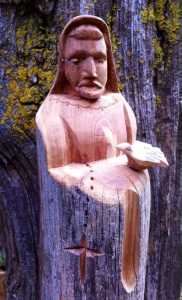
“Vast is the robe of liberation…,” we chanted as we sat together in the zendo, under the statues of Kuan Yin, known also as Kannon, and Avalokiteshvara, all “She Who Hears The Cries of The World.” This is also just another description of Our Lady of Guadalupe, whose beautiful blue robe covered in constellations of stars is simply the sky, to my eyes, the universe, compassion being the liberation of both the one who gives it as well as the one who receives it. Vast within the universe is our ability to step under that wide robe and out of time into a space that prioritizes the moment – and the person – right in front of us.
I guess I was off-map as we chanted, however; I thought we were all saying, “vast is the road of liberation.” Losing track seems to be mi carretera. And my hope.
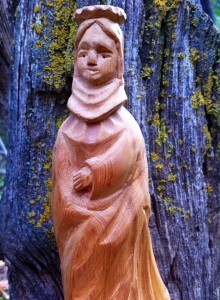
“Maybe you wonder where you are
I don’t care
Here is where time is on our side
Take you there…take you there
“We’re on a road to nowhere
We’re on a road to nowhere
We’re on a road to nowhere….”
October 11, 2014 / wanderinglightning / 0 Comments
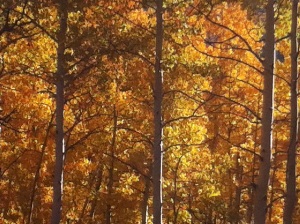 Warm in the autumn mid-afternoon, I am lazily swooning in the fiery, shimmering gold of Colorado aspens in the high country. I see each fluttering leaf, smell the dry leaves underfoot, and hear the whispering quaking…and a guy cough. Next to me, on his meditation cushion. Which brings me back to reality, here in Upaya Zen Center, in Santa Fe, New Mexico. Again and again, my mind drifts with the cool breezes that curl in through the high windows of the zendo.
Warm in the autumn mid-afternoon, I am lazily swooning in the fiery, shimmering gold of Colorado aspens in the high country. I see each fluttering leaf, smell the dry leaves underfoot, and hear the whispering quaking…and a guy cough. Next to me, on his meditation cushion. Which brings me back to reality, here in Upaya Zen Center, in Santa Fe, New Mexico. Again and again, my mind drifts with the cool breezes that curl in through the high windows of the zendo.
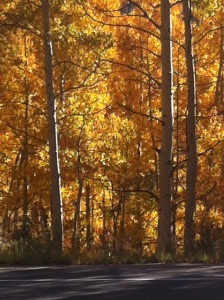 The trees. The aspens were spectacular this year, not just golden and bright as the sun, but flaming orange, and even red on a few mountain ridges. What incredible beauty I drove through to…breathe, and notice breathing, here in the zendo. Notice being here.
The trees. The aspens were spectacular this year, not just golden and bright as the sun, but flaming orange, and even red on a few mountain ridges. What incredible beauty I drove through to…breathe, and notice breathing, here in the zendo. Notice being here.
How many times do we not. In this day of silent meditation, my mind spins out stories, images, scents and sounds, until the windy rattling of the leaves of an entire aspen grove fills my mind with a completely false reality. It’s like napping with your eyes wide open.
“To be awake is to be alive.” — Henry David Thoreau, Walden Pond
The irony is that this Southwestern-style adobe Buddhist temple is spectacular, as well. Enormous posts of entire, peeled tree trunks anchor roughcut beams across the thick plaster walls. Rugged, natural wood is embedded over doorways and windows as reassuring lintels, sturdy vigas line the porch roofs and stud the smooth walls, and everywhere filtered light and softly moving air soothe and refresh. The floor is polished to a shine that reflects the light and shimmers like a lake, and I drift away in watery reveries repeatedly.
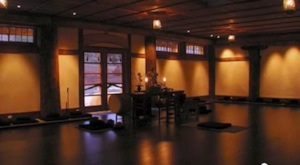
When I’m actually facing out into the room. Most zen meditation is done facing the wall. You sit maybe a foot or two away from the wall, and now, all distractions removed, you pay attention, to…sitting and breathing in front of a wall. It’s trickier than it seems, and not nearly as boring as it sounds.
Because our minds are such noisy places to live in. It’s exhausting when you first start to explore this mental terrain. That exhaustion quickly leads to the stage of life when you think you will move to a calm, quiet place, Thoreau’s cabin in the woods, where you can be happy and live simply. But what does it matter, if we live in an isolated cabin an hour from anywhere or in the middle of New York, if we bring the constant chatter-talk-drama-sirens-blaring-teary-confessions-angry-yelling-windows-breaking-hopeless-addict-craving-thrills-success-and-money-fame-nirvana with us everywhere we go?
Zen: sit down, shut up, face your wall.
Or in my case, face your tree.
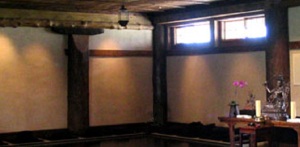
See the very thick post on the left wall? That’s my tree. My assigned seat for the weekend was directly, exactly, in front of it. As you enter the sacred space, you bow to it, hands together. You walk slowly to your place, turn to face the room, and bow to all. You turn to your seat, and you now bow to it, this humble place that is the soil of the seed of your potential wisdom.
“All change is a miracle to contemplate; but it is a miracle which is taking place every instant.” — Thoreau
We do not bow, in general, in America. Honoring is a pageant here, not an act of humility – an awards ceremony, 21-gun salute, Oscar nomination for Best Picture, valuable cash prizes. But outside the pageant, in our daily lives, we curse each other in road rage, roll our eyes and sigh while in line for our five dollar coffees, and tell little cutting stories about how our kids are actually somewhat superior to your kids gosh look at the time gotta go. We compete with each other for what shimmers like glory, that fleeting popularity, status and bragging rights, instead of offering genuine respect and honor to each other, intentionally, and with all sincerity. Seems we won’t bow to the forest for all the damn trees.
So, I bowed to the temple, and I bowed to the sangha of fellow human beings, and I bowed before I took my seat, and then, I bowed to my tree. With all sincerity. As Robert Frost would have said, my tree was “lovely, dark, and deep,” the grain a fingerprint of its life, with swellings and whirls where branches might once have been. As I sat examining its scars, it occurred to me that trees seem like the most enlightened living beings on the planet, which I know makes me sound like a kook. But when you think about it, trees: demonstrate no passions, aggressions, or ignorance; are nobly rooted to the earth and stretch their crowns toward heaven, just as we are instructed to do in zazen; engage in no profane words or deeds; live according to the seasons of their lives; shelter smaller living things that seek them; make their own food, plus food and oxygen to nourish and sustain all life on this planet; inspire us with their simple beauty and fitness of purpose, as true bodhisattvas do; and demonstrate their enlightenment by their ability to bend and bow, honoring the way life is, instead of fighting to have their way.
“I turned my face more exclusively than ever to the woods, where I was better known.” — Thoreau
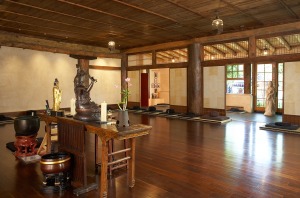 Such a small space, between me and my tree, between me and the guy next to me, who still occasionally coughed. I looked deeply into that trunk before me, and saw generations of trees, growing together, just like we were all trying to grow together, sitting side by side. Just like aspen, we are all one organism below the surface, appearing as separate individuals – but that is actually an illusion. What we do to one, what we do to each other, we do to all. We do to ourselves. Because we act upon the whole world, whether in rage or in humility.
Such a small space, between me and my tree, between me and the guy next to me, who still occasionally coughed. I looked deeply into that trunk before me, and saw generations of trees, growing together, just like we were all trying to grow together, sitting side by side. Just like aspen, we are all one organism below the surface, appearing as separate individuals – but that is actually an illusion. What we do to one, what we do to each other, we do to all. We do to ourselves. Because we act upon the whole world, whether in rage or in humility.
I swayed with the aspens periodically, but that solid trunk, unmoving before me, would bring me back. And so did the very humanness of the people sitting beside me, many trees within the Circle of the Way.
“I went to the woods because I wished to live deliberately, to front only the essential facts of life, and see if I could not learn what it had to teach, and not, when I came to die, discover that I had not lived.” — Thoreau, Walden Pond
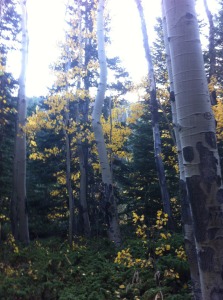
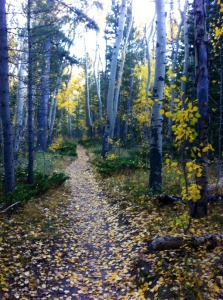
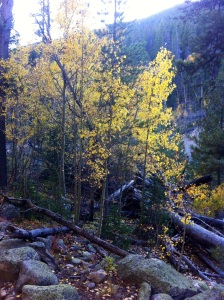
October 9, 2014 / wanderinglightning / 0 Comments
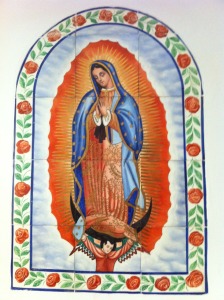
When on the road to see Our Lady of Guadalupe, you will come by many turns to Santa Fe. Roughly translated, “Santa Fe” means “city of holy faith.” The Guadalupana is Santa Fe’s gentle patron saint, a vision of kindness and mercy whose call from the hills, according to the legend, sang like the voices of many sweet birds, down to the listening ears of the peasant Juan Diego passing below:
“Let not your heart be disturbed. Do not fear….”
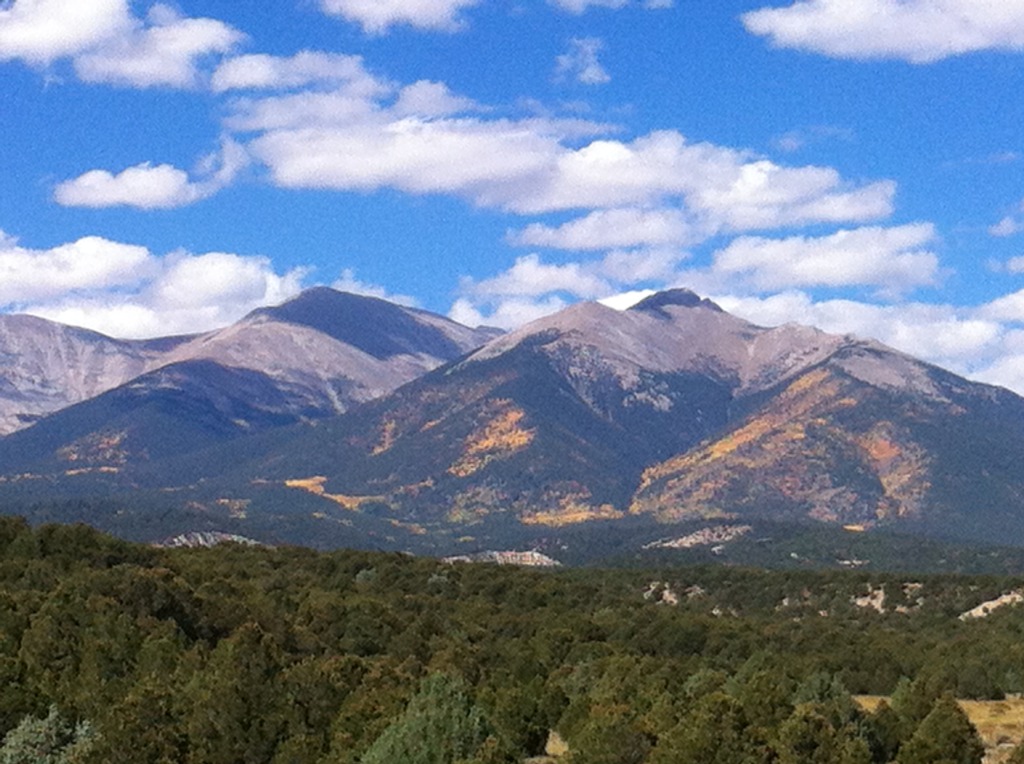
The mountains of Colorado drop back as you travel south, and the expanding vistas of northern New Mexico beckon. Beyond those guiding peaks, the road begins to meander. And so do I.
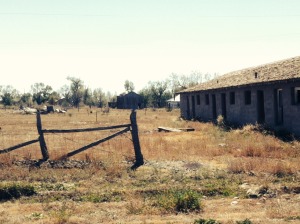 At the border sits Conejos, the only county seat in the state that’s not an actual incorporated town, population 58, total area less than half a square mile.
At the border sits Conejos, the only county seat in the state that’s not an actual incorporated town, population 58, total area less than half a square mile.
But here, Nuestra Señora de Guadalupe, Our Lady of Guadalupe Catholic Church, watches over the long San Luis Valley. The brick version is from 1948, but originally, in 1858, Our Lady raised picket walls, called jacal, around the valley faithful.
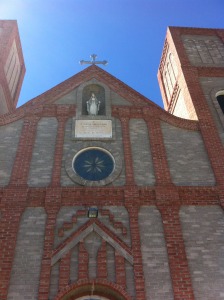
“Are you not under my protection? Are you not happily within my fold?”
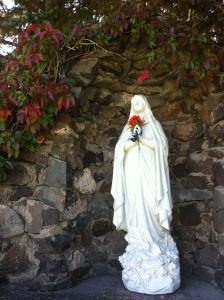 Our Lady of Guadalupe is beloved here, found again and again all along the way from Conejos to Santa Fe. Her story was published in the Nahuatl/Aztec language in 1649. The text is called the Nican Mopohua, “Here It Is Told.” It tells a story from 1531, blending Aztec, Chichimecan Indian, and Christian beliefs, wrapping ancient imagery of the Sun God and the Earth Mother in the new mysticism of Catholicism. In the story, Our Lady asks Juan Diego to build her a church on the holy hill; in this part of the country, she has been given many shrines, many hills to call home.
Our Lady of Guadalupe is beloved here, found again and again all along the way from Conejos to Santa Fe. Her story was published in the Nahuatl/Aztec language in 1649. The text is called the Nican Mopohua, “Here It Is Told.” It tells a story from 1531, blending Aztec, Chichimecan Indian, and Christian beliefs, wrapping ancient imagery of the Sun God and the Earth Mother in the new mysticism of Catholicism. In the story, Our Lady asks Juan Diego to build her a church on the holy hill; in this part of the country, she has been given many shrines, many hills to call home.
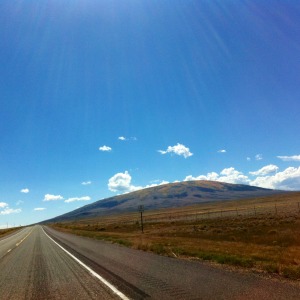
I am a peregrina, a pilgrim rolling south past the graceful arc of New Mexico’s earthen gatepost, San Antonio Mountain. I think of the hill of Tepeyac, where the apparition of “the ever-virgin Holy Mary, Mother of God” called affectionately to “Juanito,” asking him,
“Am I not here, who is your Mother?”
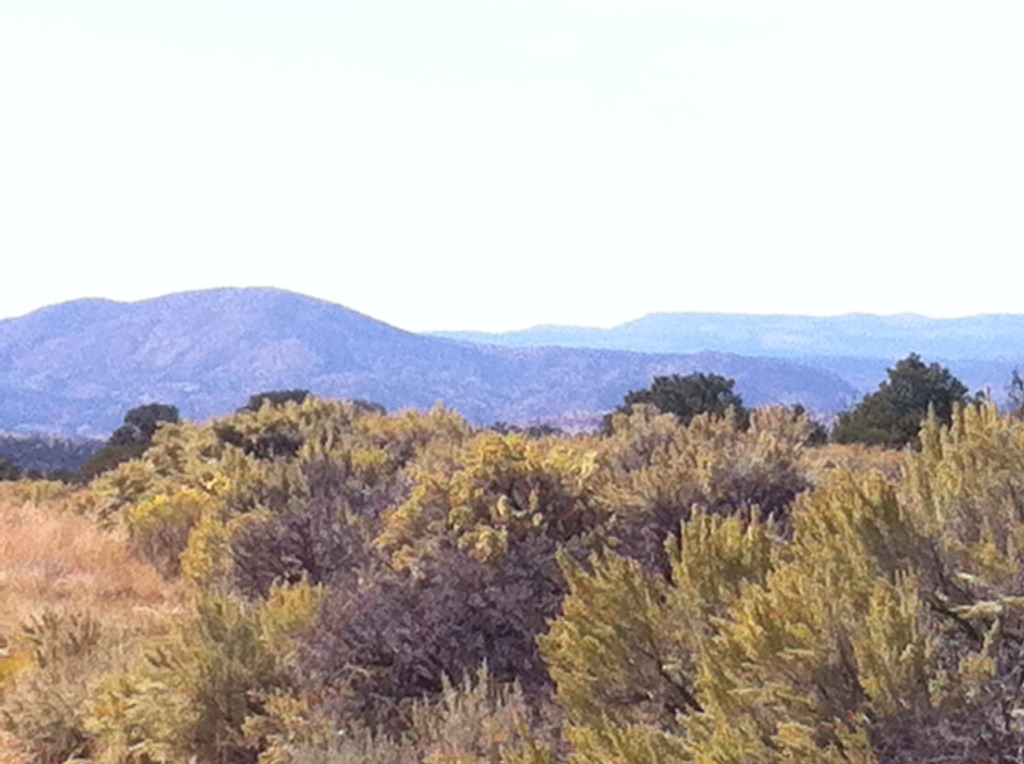
New Mexico is a feminine landscape. The hills are softer, green and gold of rounded desert chamisa, that sweet-smelling rabbitbrush, the evergreen piñon, and turquoise sage. Mesas stretch slowly across the horizon, indistinct as the last moments of dreaming upon waking, clouds continually forming far across immense valleys over distant, fading hills.
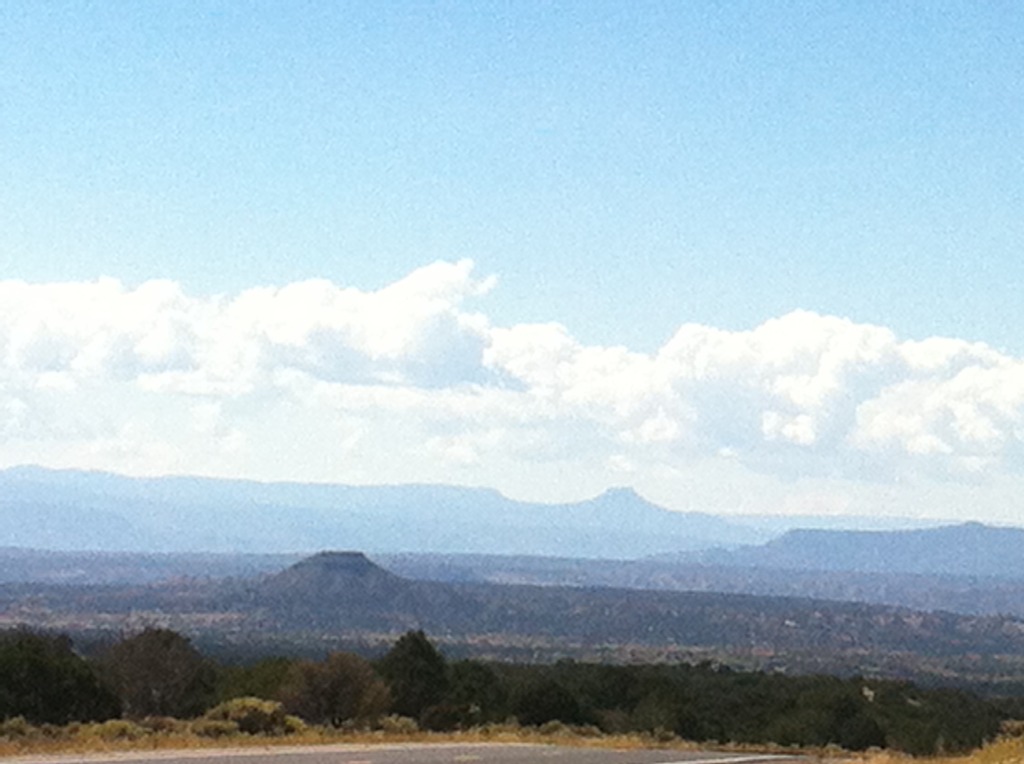
“Let not your heart be disturbed.”
The highway is leading toward Upaya Zen Center. In Sanskrit, upaya is “skillful means,” using wisdom and compassion in our interactions with others to help them grow toward enlightenment. Medios hábil: interesting that in Spanish, being able means being skillful, not just having the potential capacity to do something. You don’t just talk a good game – you get it done. The Spanish translation feels more Zen than the Sanskrit. Not a hope, but a direct statement. Not intention, but training.
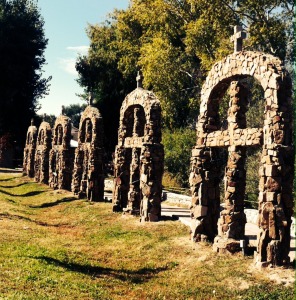 The words may sound direct, but this is New Mexico…where walls and buildings, earth and sky, all curve. So I curve, too, down a slight detour, the winding road to Chimayo. It has been almost 20 years since I have seen this small adobe chapel, and after many U-turns and missed signs, I am not completely sure I am yet on the right road. Passing tiny, dilapidated houses, dirt yards fenced in chainlink, and gardens of chiles and squash behind jacal pickets, I pull into the ubiquitous Family Dollar store parking lot, just behind a local couple getting out of a 20-year-old green Toyota. I roll down my window. “May I ask you a question? Is this the road to Chimayo?”
The words may sound direct, but this is New Mexico…where walls and buildings, earth and sky, all curve. So I curve, too, down a slight detour, the winding road to Chimayo. It has been almost 20 years since I have seen this small adobe chapel, and after many U-turns and missed signs, I am not completely sure I am yet on the right road. Passing tiny, dilapidated houses, dirt yards fenced in chainlink, and gardens of chiles and squash behind jacal pickets, I pull into the ubiquitous Family Dollar store parking lot, just behind a local couple getting out of a 20-year-old green Toyota. I roll down my window. “May I ask you a question? Is this the road to Chimayo?”
Chimayo reminds me of the word chimera, “something that exists only in imagination and is not possible in reality.” I feel like I’m asking if this is the road to magic and miracles. I think of the story of Juan Diego and Our Lady on the Hill: Juanito is just this regular guy who heard beautiful birdsong coming from the hilltop and decided to turn from the main road and wander up to see what magic this might be. Following the winding way itself became his miracle.
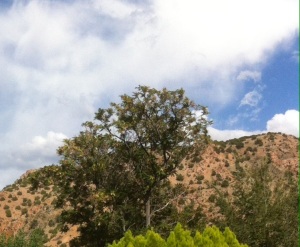
The name Chimayo actually derives from a Tewa Indian name for the hill of Tsi Mayoh, one of four sacred hills marking the four sacred directions. The soil itself was believed to have healing powers by the Tewa, who called it “blessed earth,” and this belief was picked up by Spanish settlers in the 1600s who founded the village of Chimayo on the ruin of a Tewa pueblo. In 1814, the source for digging the blessed earth, El Posito, was contained within a small church built to honor El Señor de Esquipulas, the Black Christ worshipped in Guatemala credited with healing abilities. Medios hábil. Maybe this was skillful means. Layer upon layer, like a laying on of hands, these centuries of beliefs in miraculous healing. All circling around this sacred opening in the earth.
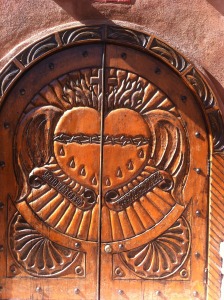
The grey-haired husband is coming around the car, smiling.
“The, uh, chapel?” I ask again.
“Santuario? Santuario de Chimayo?”
“Yes – santuario! Is this the road?” I am given specific instructions, to pass the ranchos, to look for a man’s small service station and turn there.
The woman, older than me but ageless in her grace, smiles slowly, then broadly. “This – is Chimayo.” She raises her arms as she smiles, her hands lifting palms up to the sky. “All this, all…is…Chimayo!”
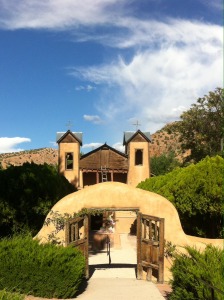 Santuario. I am seeking sanctuary, at the same time I am seeking the skills to better offer compassion and help in the world. Our Lady of Family Dollar is so wise; all this, all this is in fact the sacred hill we climb, our Tsi Mayoh, our Tepeyac, seeking the voice of the Great Mother who sings like birds, and the warmth of the Sun God on our faces, seeking the high holy place, and the deep source of healing.
Santuario. I am seeking sanctuary, at the same time I am seeking the skills to better offer compassion and help in the world. Our Lady of Family Dollar is so wise; all this, all this is in fact the sacred hill we climb, our Tsi Mayoh, our Tepeyac, seeking the voice of the Great Mother who sings like birds, and the warmth of the Sun God on our faces, seeking the high holy place, and the deep source of healing.
“Am I not your health? Do not fear that sickness, nor any other sickness or anguish.”
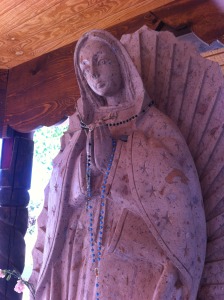 She is here as well, at Santuario de Chimayo. The Guadalupana. She is everywhere here on the rolling road to the city of holy faith…so many names, so many layers, so many incarnations.
She is here as well, at Santuario de Chimayo. The Guadalupana. She is everywhere here on the rolling road to the city of holy faith…so many names, so many layers, so many incarnations.
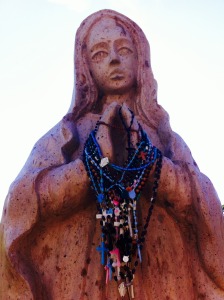 I wind my way back toward Española, then south. In Santa Fe, I take the Paseo de Peralta, curving into yet more quiet hills. I have traveled to Upaya to remember the meaning of the zendo, the holy place of practicing the stillness of the hills to quiet our noisy minds, the temple named Dokanji – Circle of the Way. Circulo del Camino. So many words, so many voices, in so many languages.
I wind my way back toward Española, then south. In Santa Fe, I take the Paseo de Peralta, curving into yet more quiet hills. I have traveled to Upaya to remember the meaning of the zendo, the holy place of practicing the stillness of the hills to quiet our noisy minds, the temple named Dokanji – Circle of the Way. Circulo del Camino. So many words, so many voices, in so many languages.
Here in the forgiving spaciousness of New Mexico, I can feel that I am just a small pilgrim, hoping to make some progress on the way. And the way is winding, circular, spiral. Like the petals of the roses Our Lady gave to Juan Diego as proof of his honest heart.
Unseen birds are twittering in the cooling twilight as I arrive. I listen carefully. Because Juan Diego listened and took the curving path up the hill, he found The Lady. By following the call of beauty and meaning, the true magic, we learn that the most skillful means can be to meander among the miracles.
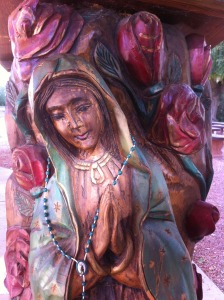
“What else do you wish? Do not grieve nor be disturbed by anything.”
 If you meet the buddha on the road, you’re supposed to kill him, according to the ancient Zen texts. They mean let go of what you believe enlightenment to be, your idealized personification of how to be in the world, usually defined as somehow not you. But what if you meet Guadalupe, over and over? I feel I am expanding, not limiting myself, by loving her personification of compassion, here among these quiet men with all the hallmarks of homelessness upon them. She feels reassuring to me, and her crowd feels very familiar.
If you meet the buddha on the road, you’re supposed to kill him, according to the ancient Zen texts. They mean let go of what you believe enlightenment to be, your idealized personification of how to be in the world, usually defined as somehow not you. But what if you meet Guadalupe, over and over? I feel I am expanding, not limiting myself, by loving her personification of compassion, here among these quiet men with all the hallmarks of homelessness upon them. She feels reassuring to me, and her crowd feels very familiar. I turned to go, when one artist’s work caught my eye, and so I crossed back on foot to the Taos side of the bridge. Here sat Mark A on a folding chair outside his van, a big man with a woodworker’s hands and many hard years etched around kind eyes, carving an old gray wooden post into an icon of a saint, his other santos on the long white table in front of him. He sells them too cheap, he knows, but…, he says, and shrugs, smiling. An 8″ tall Mary and Joseph carved from tree branches stand together, their expressions loving and real; they must be sold together, I am told. Saint Francis sits solidly on the table holding a bird, clearly carved from the same type of gray post that will now become another image of Mother Mary. I pick up a smaller female image, with a crown and a long robe. “I just came from the zen center in Santa Fe,” I tell Mark A, “and this one reminds me of Kuan Yin. You know her?”
I turned to go, when one artist’s work caught my eye, and so I crossed back on foot to the Taos side of the bridge. Here sat Mark A on a folding chair outside his van, a big man with a woodworker’s hands and many hard years etched around kind eyes, carving an old gray wooden post into an icon of a saint, his other santos on the long white table in front of him. He sells them too cheap, he knows, but…, he says, and shrugs, smiling. An 8″ tall Mary and Joseph carved from tree branches stand together, their expressions loving and real; they must be sold together, I am told. Saint Francis sits solidly on the table holding a bird, clearly carved from the same type of gray post that will now become another image of Mother Mary. I pick up a smaller female image, with a crown and a long robe. “I just came from the zen center in Santa Fe,” I tell Mark A, “and this one reminds me of Kuan Yin. You know her?”































